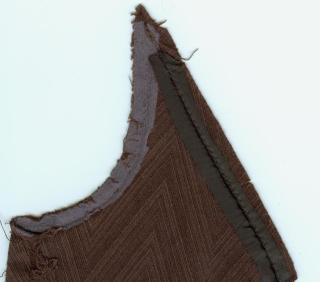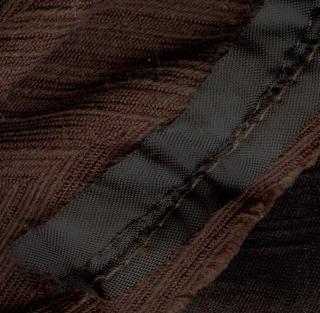Entry tags:
Decontructed dress post (from August)
The dress was (is it "is" instead, now that I've taken it apart? Or is it to late in the evening to philosophize about that?) a TAHARI - ARTHUR S. LEVINE size 6. The shell is 77% cotton, 21% polyester, and 2% spandex. The lining is 100% acetate. It's made in China, and I have to say, very well made. It is this very dress, except made in a brown herringbone fabric:
One thing I wondered when searching for pictures of the actual dress and not finding it: is the brown dress from an earlier season and the white is more recent? That would be a really good way to save some production costs. The pattern is exactly the same, just the fabric and embellishments are different. (The brown dress had brass studs around the slit and two rows down the center front waistband, as well as gold topstitching.) It screamed 90s at me in the thrift store, while the above dress does not.
Various things about this dress:
+ The lining was completely sewn in by machine, including the back kick pleat. I drew and labeled a very confusing diagram of what I thought would be the construction process. I remember thinking it was very clever and that I probably wouldn't be able to sew it that way. I was right. I came close though.
+ The construction thread was a little finer than the "all-purpose" polyester home sewing thread. And stronger.
+ The seam allowances were serged after the seams were sewn and the seams were pressed open.
+ The dress and lining were constructed separately and entirely and zipper and back seam were done last. The dress and lining were constructed in a different order.
+ The lining seemed to be the same size as the dress, not bigger or smaller, although there were wrinkles in the lining like it was too big.
+ There was a metric crap-ton of interfacing and stabilizers in this dress.
Let's take a tour:

One thing I wondered when searching for pictures of the actual dress and not finding it: is the brown dress from an earlier season and the white is more recent? That would be a really good way to save some production costs. The pattern is exactly the same, just the fabric and embellishments are different. (The brown dress had brass studs around the slit and two rows down the center front waistband, as well as gold topstitching.) It screamed 90s at me in the thrift store, while the above dress does not.
Various things about this dress:
+ The lining was completely sewn in by machine, including the back kick pleat. I drew and labeled a very confusing diagram of what I thought would be the construction process. I remember thinking it was very clever and that I probably wouldn't be able to sew it that way. I was right. I came close though.
+ The construction thread was a little finer than the "all-purpose" polyester home sewing thread. And stronger.
+ The seam allowances were serged after the seams were sewn and the seams were pressed open.
+ The dress and lining were constructed separately and entirely and zipper and back seam were done last. The dress and lining were constructed in a different order.
+ The lining seemed to be the same size as the dress, not bigger or smaller, although there were wrinkles in the lining like it was too big.
+ There was a metric crap-ton of interfacing and stabilizers in this dress.
Let's take a tour:

This is the left bodice front. It has a very fine woven interfacing on the princess seam (black strip on right) and what I learned is 3% tape on the armhole seam. I happened to check out a Threads video from the library - Threads Industry Insider Techniques, vol 2 - where they mentioned this exact thing. It's basically Armo Weft cut at a 22.5° angle (half of 45°, or half the bias). It's apparently used a lot in the tailoring industry when you need your stabilizer to be able to curve.

The above is the fine woven interfacing. The entire bodice front was interfaced, along with the front and back waistband, the neck edge, the neck facings, the kick pleat, and the hem. In the lining, the neck edge and armhole seams were interfaced.
This is a close-up of the 3% tape. You should be able to click on this pic and get a real closeup. This was used on the armscye (armhole).
Another close-up of the 3% tape.
This is some rayon (I'm assuming) stabilizing tape I found only in the armhole. I think. It's late and I don't feel like dragging the dress out of storage. I know I remember thinking the armhole stabilizing was a bit gratuitous.
Bias strips cut from the lining material were used on both the neck edge and in the seam under the invisible zipper.

The above is the fine woven interfacing. The entire bodice front was interfaced, along with the front and back waistband, the neck edge, the neck facings, the kick pleat, and the hem. In the lining, the neck edge and armhole seams were interfaced.
This is a close-up of the 3% tape. You should be able to click on this pic and get a real closeup. This was used on the armscye (armhole).
Another close-up of the 3% tape.
This is some rayon (I'm assuming) stabilizing tape I found only in the armhole. I think. It's late and I don't feel like dragging the dress out of storage. I know I remember thinking the armhole stabilizing was a bit gratuitous.
Bias strips cut from the lining material were used on both the neck edge and in the seam under the invisible zipper.




